
Crab-eating macaque
(Macaca fascicularis)
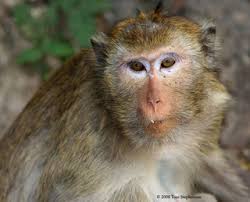
The crab-eating macaque, also known as the long-tailed macaque, is a cercopithecine primate native to Southeast Asia. It is referred to as the cynomolgus monkey in laboratories. It has a long history alongside humans; they have been alternately seen as agricultural pests, sacred animals in some temples, and more recently, the subject of medical experiments. The crab-eating macaque lives in matrilineal social groups with a female dominance hierarchy, and male members leave the group when they reach puberty. They are opportunistic omnivores and have been documented using tools to obtain food in Thailand and Myanmar. The crab-eating macaque is a known invasive species and a threat to biodiversity in several locations, including Hong Kong and western New Guinea. The significant overlap in macaque and human living space has resulted in greater habitat loss, synanthropic living, and inter- and intraspecies conflicts over resources.
Conservation status
Least concern
Scientific classification |
|
| Kingdom: | Animalia |
| Phylum: | Chordata |
| Class: | Mammalia |
| Order: | Primates |
| Family: | Cercopithecidae |
| Genus: | Macaca |
| Specie: | Macaca fascicularis |
Physical characteristics
The body length of the adult, which varies among subspecies, is 38-55 cm (15-22 in) with relatively short arms and legs. Males are considerably larger than females, weighing 5-9 kg (11-20 lb) compared to the 3-6 kg (6.6-13.2 lb) of females. The tail is longer than the body, typically 40-65 cm (16-26 in), which is used for balance when they jump distances up to 5 m (16 ft). The upper parts of the body are dark brown with light golden brown tips. The under parts are light grey with a dark grey/brown tail. Crab-eating macaques have backwards-directed crown hairs which sometimes form short crests on the midline. Their skin is black on their feet and ears, whereas the skin on the muzzle is a light grayish pink color. The eyelids often have prominent white markings and sometimes there are white spots on the ears. Males have a characteristic mustache and cheek whiskers, while females have only cheek whiskers. Crab-eating macaques have a cheek pouch which they use to store food while foraging. Females show no perineal swelling.Distribution and habitat
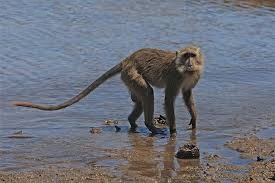
The crab-eating macaque lives in a wide variety of habitats, including primary lowland rainforests, disturbed and secondary rainforests, shrubland, and riverine and coastal forests of nipa palm and mangrove. They also easily adjust to human settlements; they are considered sacred at some Hindu temples and on some small islands, but are pests around farms and villages. Typically, they prefer disturbed habitats and forest periphery. The native range of this species includes most of mainland Southeast Asia, from extreme southeastern Bangladesh south through Malaysia, and the Maritime Southeast Asia islands of Sumatra, Java, and Borneo, offshore islands, the islands of the Philippines, and the Nicobar Islands in the Bay of Bengal. This primate is a rare example of a terrestrial mammal that violates the Wallace line.
Group living
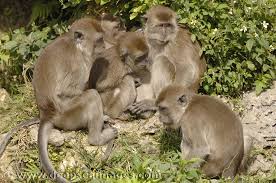
Macaques live in social groups that contain three to 20 females, their offspring, and one or many males. The groups usually have fewer males than females. In social groups of macaques, a clear dominance hierarchy is seen among females. These ranks remain stable throughout the female’s lifetime and also can be sustained through generations of matrilines. Females have their highest birth rates around 10 years of age and completely stop bearing young by age 24.
The social groups of macaques are female-bonded, meaning the males will disperse at the time of puberty. Thus, group relatedness on average appears to be lower than compared to matrilines. More difference in relatedness occurs when comparing high-ranking lineages to lower ranking lineages, with higher-ranking individuals being more closely related to one another. Additionally, groups of dispersing males born into the same social groups display a range of relatedness, at times appearing to be brothers, while at other times appearing to be unrelated.
In addition to the matrilineal dominance hierarchy, male dominance rankings also exist. Alpha males have a higher frequency of mating compared to their lower-ranking conspecifics. The increased success is due partially to his increased access to females and also due to female preference of an alpha male during periods of maximum fertility. Though females have a preference for alpha males, they do display promiscuous behavior. Through this behavior, females risk helping to rear a nonalpha offspring, yet benefit in two specific ways, both in regard to aggressive behavior. First, a decreased value is placed on one single copulation. Moreover, the risk of infanticide is decreased due to the uncertainty of paternity.
Increasing group size leads to increased competition and energy spent trying to forage for resources, and in particular, food. Further, social tensions build and the prevalence of tension-reducing interactions like social grooming fall with larger groups. Thus, group living appears to be maintained solely due to the safety against predation.
Conflict
Group living in all species is dependent on tolerance of other group members. In crab-eating macaques, successful social group living maintains postconflict resolution must occur. Usually, less dominant individuals lose to a higher-ranking individual when conflict arises. After the conflict has taken place, lower-ranking individuals tend to fear the winner of the conflict to a greater degree. In one study, this was seen by the ability to drink water together. Postconflict observations showed a staggered time between when the dominant individual begins to drink and the subordinate. Long-term studies reveal the gap in drinking time closes as the conflict moves further into the past.Grooming and support in conflict among primates is considered to be an act of reciprocal altruism. In crab-eating macaques, an experiment was performed in which individuals were given the opportunity to groom one another under three conditions: after being groomed by the other, after grooming the other, and without prior grooming. After a grooming took place, the individual that received the grooming was much more likely to support its groomer than one that had not previously groomed that individual. These results support the reciprocal altruism theory of grooming in long-tailed macaques.
Crab-eating macaques demonstrate two of the three forms of suggested postconflict behavior. In both captive and wild studies, the monkeys demonstrated reconciliation, or an affiliative interaction between former opponents, and redirection, or acting aggressively towards a third individual. Consolation was not seen in any study performed.
Postconflict anxiety has been reported in crab-eating macaques that have acted as the aggressor. After a conflict within a group, the aggressor appears to scratch itself at a higher rate than before the conflict. Though the scratching behavior cannot definitely be termed as an anxious behavior, evidence suggests this is the case. An aggressor’s scratching decreases significantly after reconciliation. This suggests reconciliation rather than a property of the conflict is the cause of reduction in scratching behavior. Though these results seem counterintuitive, the anxiety of the aggressor appears to have a basis in the risks of ruining cooperative relationships with the opponent.
Kin altruism and spit
In a study, a group of crab-eating macaques was given ownership of a food object. Unsurprisingly, adult females favored their own offspring by passively, yet preferentially, allowing them to feed on the objects they held. Interestingly, when juveniles were in possession of an object, mothers robbed them and acted aggressively at an increased rate towards their own offspring compared to other juveniles. These observations suggest close proximity influences behavior in ownership, as a mother’s kin are closer to her on average. When given a nonfood object and two owners, one being a kin and one not, the rival will choose the older individual to attack regardless of kinship. Though the hypothesis remains that mother-juvenile relationships may facilitate social learning of ownership, the combined results clearly point to aggression towards the least-threatening individual.A study was conducted in which food was given to 11 females. They were then given a choice to share the food with kin or nonkin. The kin altruism hypothesis suggests the mothers would preferentially give food to their own offspring. Yet eight of the 11 females did not discriminate between kin and nonkin. The remaining three did, in fact, give more food to their kin. The results suggest it was not kin selection, but instead spite that fueled feeding kin preferentially. This is due to the observation that food was given to kin for a significantly longer period of time than needed. The benefit to the mother is decreased due to less food availability for herself and the cost remains great for nonkin due to not receiving food. If these results are correct, crab-eating macaques are unique in the animal kingdom, as they appear not only to behave according to the kin selection theory, but also act spiteful toward one another.
Reproduction

After a gestation period of 162–193 days, the female gives birth to one infant. The infant's weight at birth is about 320 g (11 oz). Infants are born with black fur which will begin to turn to a yellow-green, grey-green, or reddish-brown shade (depending on the subspecies) after about three months of age. This natal coat may indicate to others the status of the infant, and other group members treat infants with care and rush to their defense when distressed. Immigrant males sometimes kill infants not their own, and high-ranking females sometimes kidnap the infants of lower-ranking females. These kidnappings usually result in the death of the infants, as the other female is usually not lactating. A young juvenile stays mainly with its mother and relatives. As male juveniles get older, they become more peripheral to the group. Here they play together, forming crucial bonds that may help them when they leave their natal group. Males that emigrate with a partner are more successful than those that leave alone. Young females, though, stay with the group and become incorporated into the matriline into which they were born.
Male crab-eating macaques groom females to increase the chance of mating. A female is more likely to engage in sexual activity with a male that has recently groomed her than with one that has not.
Diet
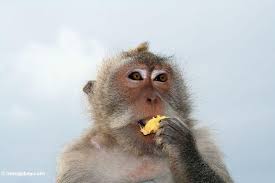
Crab-eating macaques typically do not consume crabs; rather, they are opportunistic omnivores, eating a variety of animals and plants. Although fruits and seeds make up 60 - 90% of their diet, they also eat leaves, flowers, roots, and bark. They sometimes prey on vertebrates (including bird chicks, nesting female birds, lizards, frogs, and fish), invertebrates, and bird eggs. In Indonesia, the species has become a proficient swimmer and diver for crabs and other crustaceans in mangrove swamps. A study in Bukit Timah, Singapore recorded a diet consisting of 44% fruit, 27% animal matter, 15% flowers and other plant matter, and 14% food provided by humans.
This species exhibits particularly low tolerance for swallowing seeds. Despite their inability to digest seeds, many primates of similar size swallow large seeds, up to 25 mm (0.98 in), and simply defecate them whole. The crab-eating macaque, though, spits seeds out if they are larger than 3–4 mm (0.12-0.16 in). This decision to spit seeds is thought to be adaptive; it avoids filling the monkey’s stomach with wasteful bulky seeds that cannot be used for energy.
Although the species is ecologically well-adapted and poses no threat to population stability of prey species in its native range, in areas where the crab-eating macaque is not native, it can pose a substantial threat to biodiversity. Some believe the crab-eating macaque is responsible for the extinction of forest birds by threatening critical breeding areas as well as eating the eggs and chicks of endangered forest birds.
The crab-eating macaque can become a synanthrope, living off human resources. They are known to feed in cultivated fields on young dry rice, cassava leaves, rubber fruit, taro plants, coconuts, mangos, and other crops, often causing significant losses to local farmers. In villages, towns, and cities, they frequently take food from garbage cans and refuse piles. The species can become unafraid of humans in these conditions, which can lead to macaques directly taking food from people, both passively and aggressively.
Tool use
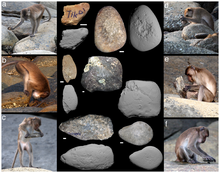
In Thailand and Myanmar, crab-eating macaques use stone tools to open nuts, oysters, and other bivalves, and various types of sea snails (nerites, muricids, trochids, etc.) along the Andaman sea coast and offshore islands.
Another instance of tool use is washing and rubbing foods such as sweet potatoes, cassava roots, and papaya leaves before consumption. Crab-eating macaques either soak these foods in water or rub them through their hands as if to clean them. They also peel the sweet potatoes, using their incisors and canine teeth. Adolescents appear to acquire these behaviors by observational learning of older individuals.
Relationship with humans
Crab-eating macaques extensively overlap with humans across their range in Southeast Asia. Consequently, they live together in many locations. Some of these areas are associated with religious sites and local customs, such as the temples of Bali in Indonesia, Thailand, and Cambodia, while other areas are characterized by conflict as a result of habitat loss and competition over food and space. Humans and crab-eating macaques have shared environments since prehistoric times, and tend to both frequent forest and river edge habitats. Crab-eating macaques are occasionally used as a food source for some indigenous forest-dwelling peoples. In Mauritius, they are captured and sold to the pharmaceutical industry, and in Angaur and Palau, they are sold as pets. Macaques feed on sugarcane and other crops, affecting agriculture and livelihoods, and can be aggressive towards humans. Macaques may carry potentially fatal human diseases, including herpes B virus.Zoológico de Vallarta A. C.
Leave your comments, your opinion is important to us

